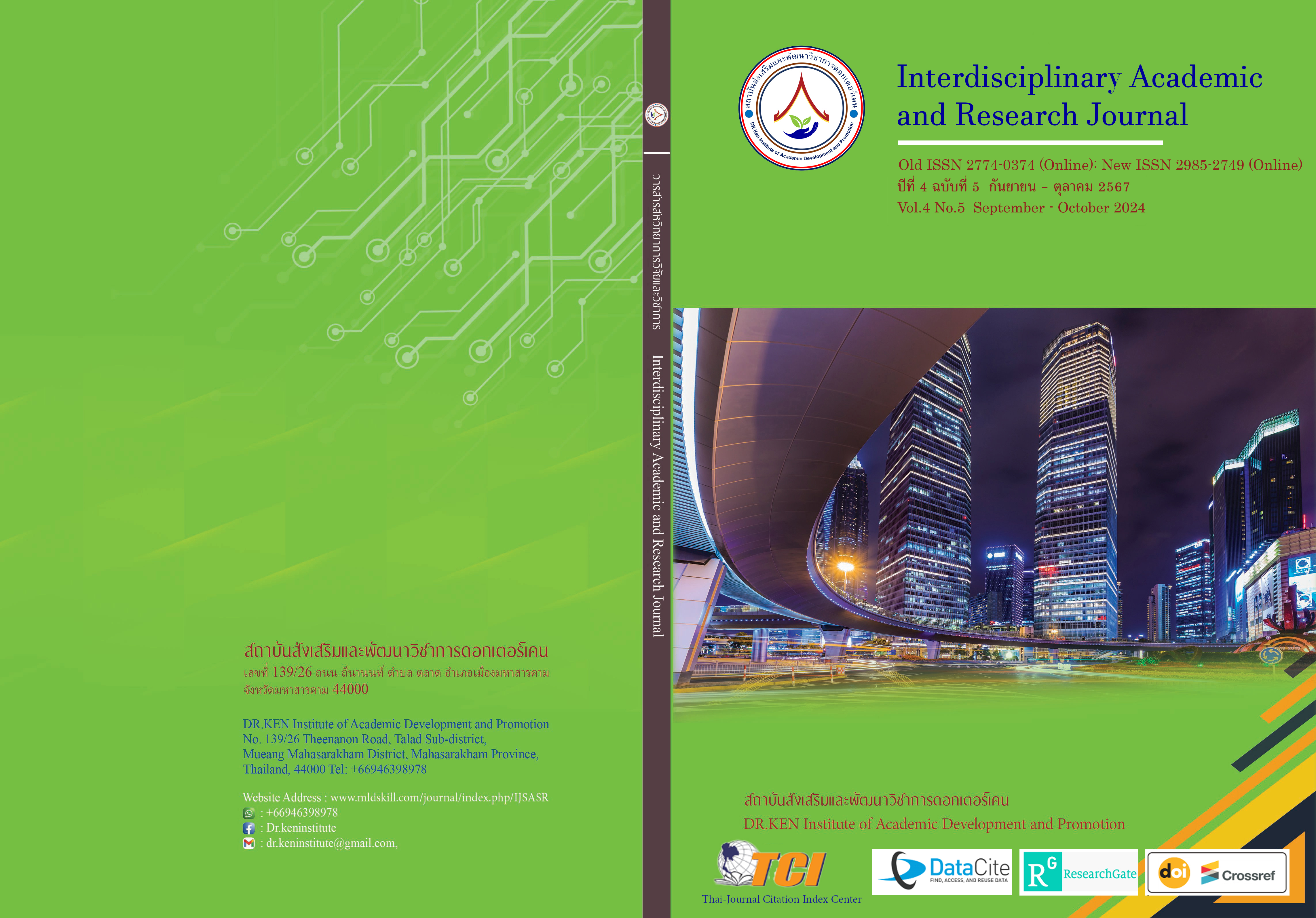The Use of Technology in the Management of Educational Institution Administrators Nakhon Ratchasima Primary Educational Service Area Office 4
DOI:
https://doi.org/10.60027/iarj.2024.276217Keywords:
Using technology in Management; , Management of executivesAbstract
Background and Aims: Nowadays, technology clearly plays an important role in people's daily lives. We live in an era where borderless communication has made great progress. Various conveniences have been invented and developed that help in human life. Allows us to access information quickly and more conveniently. More and more, therefore, humans are beginning to see the importance of information and its use. As a result, technology has become an important part that strengthens the basic necessities of life. Learning and adapting to new technology is necessary now and in the future. This research aims to: (1) Study the level of use of technology in administration by school administrators under the Nakhon Ratchasima Primary Educational Service Area Office 4. (2) Compare opinions about the use of technology in administration between school administrators and teachers in Nakhon Ratchasima Primary Educational Service Area Office 4. (3) Study guidelines for developing the use of technology in the administration of school administrators in the Nakhon Ratchasima Primary Educational Service Area Office 4.
Methodology: The research sample consisted of 317 school administrators and teachers. The sample size was determined according to Krejci and Morgan's table. This resulted in a consistency index between 0.80 and 1.00, while the reliability value of the entire questionnaire was 0.86. For data analysis, statistics such as frequency, percentage, mean, and standard deviation were used. Including t-test. and examining the pairwise average by dividing the F value.
Results: The results of the research are as follows: (1) The use of technology in the management of school administrators under the Nakhon Ratchasima Primary Educational Service Area Office 4, overall and in each aspect, is at a high level. (2) Results of comparing opinions on the use of technology in the administration of educational institution administrators according to position. Work experience and the size of the educational institution found that there was no difference. (3) Guidelines for developing the use of technology in the administration of educational institution administrators under the Nakhon Ratchasima Primary Educational Service Area Office 4, consisting of 4 areas: 1) academic administration, 2) budget management, 3) Human resource management and 4) general administration
Conclusion: Development of the use of technology in the management of educational institution administrators under the jurisdiction of the Nakhon Ratchasima Primary Educational Service Area Office 4, resulting in change and creating opportunities for the organization. modification organizational operating structure to increase efficiency in production and service relationships within the organization.
References
กระทรวงเทคโนโลยีสารสนเทศและการสื่อสาร. (2554). กรอบนโยบายเทคโนโลยีสารสนเทศและการสื่อสาร ระยะ พ.ศ. 2554 – 2563 ของประเทศไทย. กรุงเทพฯ: กระทรวงเทคโนโลยีสารสนเทศและการสื่อสาร.
กระทรวงศึกษาธิการ. (2553). พระราชบัญญัติการศึกษาแห่งชาติ พ.ศ. 2542 ที่แก้ไขเพิ่มเติม (ฉบับที่2) พ.ศ.2545 และที่แก้ไขเพิ่มเติม (ฉบับที่ 3) พ.ศ. 2553. กรุงเทพฯ: โรงพิมพ์องค์การรับส่งสินค้าและพัสดุภัณฑ์ (ร.ส.พ.).
ทิพวัลย์ นนทเภท. (2557). การใช้เทคโนโลยีสารสนเทศเพื่อการบริหารของสถานศึกษาในสังกัดสำนักงานเขตพื้นที่การศึกษาประถมศึกษานครศรีธรรมราช เขต 3. วิทยานิพนธ์ครุศาสตร มหาบัณฑิต สาขาวิชาการบริหารการศึกษา มหาวิทยาลัยราชภัฏนครศรีธรรมราช.
บุญชม ศรีสะอาด. (2553). การวิจัยเบื้องต้น. กรุงเทพฯ : สุวีริยาสาส์น.
พิชญาณี กาหลง และคณะ. (2560). แนวทางการใช้เทคโนโลยีสารสนเทศเพื่อการบริหารของ สถานศึกษาขั้นพื้นฐาน สังกัดสำนักงานเขตพื้นที่การศึกษาประถมศึกษาชัยภูมิ เขต 1. มหาวิทยาลัยราชภัฎมหาสารคาม. วารสารบัณฑิตวิจัย, 11(1), 149 – 162.
รัชฎาพร มีอาษา. (2555). การใช้เทคโนโลยีสารสนเทศในการบริหารงานวิชาการของผู้บริหารสถานศึกษา อำเภอเมืองสระแก้ว สังกัดสำนักงานเขตพื้นที่การศึกษาประถมศึกษา สระแก้ว เขต 1. วิทยานิพนธ์การศึกษามหาบัณฑิต สาขาวิชาการบริหารการศึกษา คณะศึกษาศาสตร์ มหาวิทยาลัยบูรพา.
วันวดี กู้เมือง. (2554). ความสัมพันธ์ระหว่างความเป็นผู้บริหารมืออาชีพของผู้บริหารโรงเรียนกับประสิทธิผลการบริหารงานโรงเรียน สังกัดสำนักงานเขตพื้นที่การศึกษาประถมศึกษานครศรีธรรมราช เขต 3. วิทยานิพนธ์ครุศาสตรมหาบัณฑิต, สาขาวิชาการบริหารการศึกษา มหาวิทยาลัยราชภัฏสุราษฎร์ธานี.
สงบ อินทรมณี. (2562). การบริหารสถานศึกษาในยุคดิจิทัล. วารสารวิชาการมหาวิทยาลัย การจัดการและเทคโนโลยีอีสเทิร์น, 16(1), 353 – 360.
สร้อยวสันต์ ศรีคําแหง. (2556). การบริหารงบประมาณของสถานศึกษาขั้นพื้นฐาน สังกัดสำนักงานเขตพื้นที่การศึกษาสุพรรณบุรี เขต 1. วิทยานิพนธ์ครุศาสตรมหาบัณฑิตสาขาวิชาการบริหารการศึกษา บัณฑิตวิทยาลัย มหาวิทยาลัยราชภัฏสวนดุสิต, กรุงเทพฯ.
สำนักงานเขตพื้นที่การศึกษาประถมศึกษานครราชสีมา เขต 4. (2563). ทิศทางการพัฒนาการศึกษาด้านเทคโนโลยีเพื่อการศึกษา. นครราชสีมา: สำนักงานเขตพื้นที่การศึกษาประถมศึกษานครราชสีมา เขต 4.
สำนักงานเลขาธิการสภาการศึกษา. (2560). แผนการศึกษาแห่งชาติ 2560 - 2579. กรุงเทพฯ: โรงพิมพ์แห่งจุฬาลงกรณ์มหาวิทยาลัย.
หฤทัย อรุณศิริ. (2558). ปัญหาการใช้เทคโนโลยีสารสนเทศในสถานศึกษาตามความคิดเห็นของผู้บริหารและครูสังกัดสำนักงานเขตพื้นที่การศึกษาประถมศึกษาสิงห์บุรี. วารสารวิชาการ มหาวิทยาลัยกรุงเทพธนบุรี. 3(2), 43-51.
อนุชา สีหาวัฒน์. (2553). การศึกษาการใช้เทคโนโลยีสารสนเทศเพื่อการบริหารสถานศึกษาของ สถานศึกษา สังกัดสำนักงานเขตพื้นที่การศึกษาชัยภูมิ เขต 1. วิทยานิพนธ์ครุศาสตร มหาบัณฑิตสาขาวิชาการบริหารการศึกษา มหาวิทยาลัยราชภัฏชัยภูมิ.
เอกราช เครือศรี. (2558). การใช้เทคโนโลยีสารสนเทศในการบริหารงานของผู้บริหารสถานศึกษา สังกัดสำนักงานเขตพื้นที่การศึกษามัธยมศึกษา เขต 32. วิทยานิพนธ์ครุศาสตรมหาบัณฑิต, สาขาวิชาการบริหารการศึกษา มหาวิทยาลัยราชภัฏบุรีรัมย์
Krejcie, R. V., & Morgan, D. W. (1970). Determining sample size for research activities. Educational and Psychological Measurement, 30(3), 607–610.
Downloads
Published
How to Cite
Issue
Section
License
Copyright (c) 2024 Interdisciplinary Academic and Research Journal

This work is licensed under a Creative Commons Attribution-NonCommercial-NoDerivatives 4.0 International License.
Copyright on any article in the Interdisciplinary Academic and Research Journal is retained by the author(s) under the under the Creative Commons Attribution-NonCommercial-NoDerivatives 4.0 International License. Permission to use text, content, images, etc. of publication. Any user to read, download, copy, distribute, print, search, or link to the full texts of articles, crawl them for indexing, pass them as data to software, or use them for any other lawful purpose. But do not use it for commercial use or with the intent to benefit any business.
















.png)


